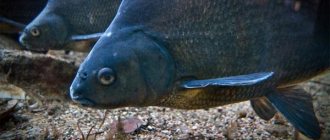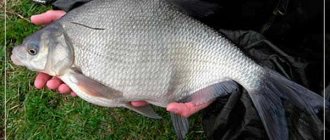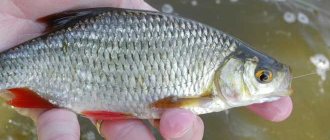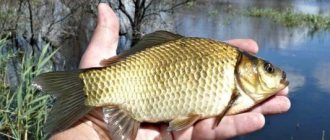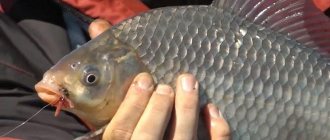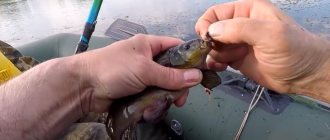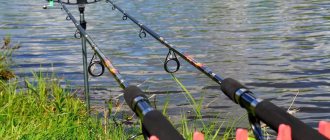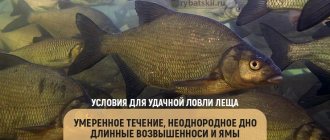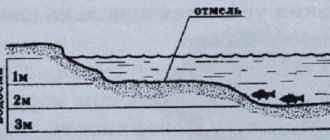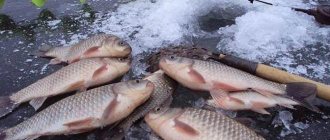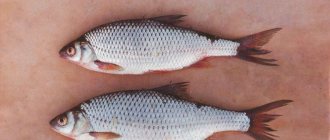After the onset of spring, bream leaves their wintering pits and moves closer to the shores to a depth of 2-5 m, where the bottom is characterized by various irregularities.
Often such places are located in the area of the riverbed, where the water flow provides fish with food washed away by the flood. Also, running water is highly saturated with oxygen, and when it is mixed with already heated water in shallow water, the optimal temperature for the life of bream is formed.
Spawning most often begins at the end of April or at the beginning of May, and this period continues until approximately the beginning of June. This type of fish spawns in flooded meadows, in reed rhizomes, as well as on other plants submerged in water due to spring floods. After spawning, mature bream individuals move to deeper places in the reservoir.
Bream on the feeder
It is best to catch bream on a feeder at the end of April and early May, when the bream has already fed a little and heads to the spawning grounds.
At this time there is a high chance of catching a good specimen. Feeder fishing is carried out at a distance of approximately 15-30 m from the shore. It will be very convenient to use a bottom fishing rod in strong wind conditions.
The length of the rod should be at least 3 m, the size of the reel should be 2000-3000 with a fishing line of 0.25 mm. The thickness of the line for the leash is 0.14-0.16 mm, and its length varies between 20 and 50 cm. The feeder is selected taking into account the strength of the current of the reservoir and the composition of the bait itself.
On rivers, triangular or quadrangular feeders made of metal mesh are used, while when feeder fishing in standing reservoirs, closed feeders with a mixture containing bloodworms or maggots are most often used.
Rod
To catch bream in the vast expanse of a large, deep river, where the casting range of the equipment is from 50 to 100 m, feeder rods 3.5 meters long of the heavey or extra-heavey class with a test of 60-80 grams are used. If you plan to fish in a small reservoir, where the casting range is no more 20 meters, then use a 3-meter picker with 30-50 grams of dough.
We also recommend reading:
Catching bream with a ring: technique, feeder and tackle with your own hands Bait for winter bream: preparation, application features Winter fishing for bream with a small pull Winter fishing for bream with a float
Searching for bream in spring
In the spring, the first place to look for bream is in areas of reservoirs that are characterized by a rocky or clay bottom. Bream can also hang out on shell shallows all day. On days with good, clear weather, bream often visits shallow water in areas near riverbeds and various holes. In general, the most promising areas for catching this fish are places remote from the shore.
When fishing, you should study the bottom of the reservoir well. Bream are attracted to areas with stones, snags and flooded trees, as well as all sorts of relief irregularities. In rivers, you should look for this fish in areas with steep banks, not far from old riverbeds.
If you can’t find a good place with a good bite, you can try to attract bream with bait. The presence of bream in a particular area is determined by observing the surface of the water: when the fish “melts” in the morning or evening, light splashes and characteristic circles on the water are visible.
Where to look for bream?
Bream is a very shy fish and, as experience shows, its shyness increases even more with age. Therefore, the main habitat of this fish is deep-sea places. Bream prefers reservoirs with a curved topography with holes and a rocky bottom. Here he feels safer. Bream overwinters in deep holes located at a depth of about twelve meters.
However, after the onset of spring, it leaves its wintering grounds and migrates closer to the shore. Bream looks for places with uneven bottom relief, such as channel edges. The clean water that arrives there, enriched with oxygen, brings food washed up by spring streams. In coastal areas, especially with dense vegetation, it can feast on dragonfly larvae, caddis flies, and so on.
The tendency of bream in the pre-spawning period to move closer to the coastlines is explained by the fact that there the water is warmest and there is a greater chance of finding food. After the end of spawning, sexually mature individuals return to a depth that is comfortable for them, and young animals can still linger for some time near the shore.
Bream baits and lures
In early spring, when the water has not yet warmed up, it is better to use animal bait as bait, including bloodworms, maggots, caddis flies and others. It is appropriate to fish for bloodworms in water bodies in which these larvae are present in large numbers. It is better to use the worm in more or less warm water. You can also combine several baits.
As the water temperature rises and the spawning period approaches, it is worth trying fishing with plant baits. These can be semolina, steamed pearl barley, canned corn and others.
Fishing tactics and equipment features
The most effective tackle for catching bream during this period, undoubtedly, remains a feeder. The feeder allows you to cast to the required distance and place a portion of bait close to the hook with bait, which in itself is an attractive factor. When choosing a feeder, it is very important to pay attention to the fact that after lowering to the bottom, it lies motionless and does not succumb to displacement under the flow of water, otherwise its “dance” will scare away the wary bream.
Often, fishermen, trying to get rid of the “dancing” of the feeder, make various modifications: this is an increase in the weight of the feeder by mounting “Cheburashkas” in its basket, which are used in spinning fishing; equipment on the sides of the feeder - wire mustaches or arcs with which the feeder will cling to the ground, etc. Although in fairness, I note that nowadays it is not so difficult to choose a feeder feeder of the required weight and shape (with a rectangular, triangular or teardrop-shaped cross-section) in a fishing store. Paying attention to the shape, remember that the most stable feeders are those in which the lead is mounted on the entire plane of the “sole”, and not in a narrow strip in its center. In addition, feeder feeders, in which the width of the “sole” is greater than the height itself, are the most resistant to tipping over.
Speaking about the equipment itself, it’s a matter of taste – a “paternoster”, a symmetrical loop or a “helicopter”. The only limitation can be the use of an anti-twist tube, as it can tremble, echoing the fluctuations of the water masses. But again, this is my opinion and I will not deny that I have seen quite effective bream fishing with such equipment. I myself fish with an asymmetrical loop and confidently consider such equipment to be the “only suitable” one for this matter.
Leashes for catching bream should be long, from 0.7 to 1 meter. Having straightened out in the current, he will remove the hook with bait from the rig, and thus all its movements when carefully tightening the line at the moment of biting will be hidden from the eyes of the bream, which gives the fisherman a head start in time for a successful and timely hook.
The most “tasty” bait for bream will be a worm, maggot, or bloodworm because they contain a large amount of protein, which the fish needs in the spring. It’s a good idea to experiment with “sandwiches”, combining both plant and animal components for the bait.
It would not be fair to ignore the topic of bait, since without it, catching bream would be more an accident than a pattern. It is necessary to feed the bream, but remember that in the spring the fish do not need a lot of food. Remember also that the bait should be localized as much as possible at the bottom, and have increased inertness and viscosity.
Don’t try to base your fishing tactics solely on the fact that bream will come to the bait you provide. You need to start from knowledge of the reservoir, its bottom characteristics and feeding places for schools of bream. If your knowledge in this area is not significant, then at least try to find evidence that bream actually feeds in one place or another. Visual signs of the presence of bream may be: clouds of turbidity rising from the bottom; pop-up air bubbles; slight disturbances of water on the surface from the passage of fish.
And finally
Bait for bream in spring
In spring it is difficult to do without special feeding. Bream really like sweet mixtures, so an excellent bait composition would be, for example, corn with a cinnamon flavor (or vanilla as an option). Effective bait is also obtained by mixing homemade cereals with special store-bought formulations.
You can add the following to the purchased mixture:
- bloodworm
- powdered milk
- pearl barley
- Hercules
- chopped worms and maggots.
Groundbait and lures
To feed bream in the spring, it is better to use various mixtures based on pearl barley, millet, and breadcrumbs. To attract a school of bream and keep them in the fishing spot for a longer time, you will need a lot of complementary food. It is also necessary to use flavorings, but observe moderation; it is better to not add enough, otherwise the fish can be scared away from the fishing spot. It is better to do a good feeding at the beginning of fishing, and then only occasionally recast. You need to feed very small areas, and cast as accurately as possible, then the catch is guaranteed.
Where to catch bream
The life cycle and habitats of bream are closely tied to weather and temperature. Waking up after a deep winter, bream still does not like to swim into shallow water, especially during the day in April and May. But in order to find food for its favorite animal food during this period, the bream gathers in schools that approach the muddy bottom to the shallow water to the very edge of the algae. If you feed such a cool place without spooking this very cautious fish with random noise, then a skilled fisherman will collect a huge catch in such a place, but it will consist mostly of small bream.
Bream can be caught both in rivers and in ponds, lakes and seas. This fish spends most of its time near the muddy bottom at depth, where it tries to avoid the heat of the day, and in the morning and evening it goes to shallow water to feed.
When the spring sun gains momentum and the water warms up a little, the fattened bream in the rivers looks upstream to their spawning grounds. Such places usually find themselves in the area of deep holes and oxbow lakes, in places with weak currents. Schools of bream in the period before spawning are the largest and come closest to the shore during daytime migrations in search of food. Spawning begins in suitable warm weather conditions around mid-spring and can last until May.
Choosing a fishing spot for spring bream
First of all, when you find yourself on a body of water, be it a river with a medium or small current, using a visual inspection we select suitable places where white fish, in particular bream, can accumulate.
In the spring, bream prepares for the upcoming spawning, which means that in some reservoirs a ban on catching it comes into force. But if there is no such ban, then you can safely begin preparing for bream fishing.
Due to the muddy and deep water, the fish will choose parking places not far from the coastal dumps at shallow depths. Small pockets and creeks are considered good places. There is practically no current at such points, and the water here warms up much faster than on the main channel. Due to the rapid heating of the coastal zone and water, various microorganisms, larvae, and plankton, which are the main food source for bream, come to life earlier after a long winter. Large schools of fish accumulate in such places, and this greatly simplifies the task for the fisherman.
Feeder on the lake choosing a fishing spot
The lakes are rich in fish, but it is not evenly distributed on them; often schools choose certain areas and stick to them, so fishing with a feeder on the lake will be successful only if you find fishing spots.
Here, just like on the river, the law of opposites operates. If the reservoir is heavily covered with vegetation, then the fish will stay in open areas, and vice versa, among clear water surfaces, the fish tries to accumulate near places where there is vegetation or near snags and trees that have fallen into the water. Promising places for lake fishing are islands and channels between them, as well as areas where the current borders on standing water. As for the bottom topography, the fish stays on edges, slopes, depressions, various underwater ridges or moves along them.
Depth sounding
Arriving at an unknown body of water, you need to find the edge on which the fish is standing. Due to the fact that the lake has a rather complex topography, it may have several edges, and most will lead to even greater depths. Which edge the fish will stand on depends on the weather conditions. The edge is the area where the bottom topography breaks, the upper part of the break is the upper edge, the lower part, which turns into a gentle descent or rise, is the lower edge, respectively. Basically, the fish prefers to stand on the lower edge, this is where the feeder on the lake will be most effective; the fish comes to the upper edge in the late afternoon (if it is warm summer days). It makes no sense to fish on the slope of the edge itself, since the feeder will roll off it, and you will not be able to create a normal feeding spot.
Determination of bottom relief
On reservoirs densely and evenly overgrown with reeds, the edge can be determined visually. Reeds grow at a depth of up to two meters, and if you see how the strip of reeds ends abruptly and is followed by a clear water surface, then you have found the beginning of the edge.
But that’s not all, because to successfully fish with a feeder on the lake, we need to find the bottom edge. Why take a weight and a braided fishing line (it has better sensitivity than a monk). We throw out the tackle and start reeling, if the weight goes effortlessly, and then we feel noticeable resistance, it means there is a lift here (the beginning of the lower edge).
If the load falls through or hangs, then in this place the bottom is uneven and there are various holes; the fish also does not ignore such areas. While reeling in, we simultaneously determine the type of bottom; on a rocky and shell-covered bottom, the load moves with noticeable shaking; on hard ground, smoothly and easily; on muddy ground, a slight tension is felt. You can also measure the bottom topography using a marker float.
Casting
To fix the casting distance, it is better to use a marker, for which we mark an area on the fishing line with a length of 50-100 cm, and then periodically update the marking, since after a while it will be erased. You can fix the line with a clip only when catching small fish (roach, silver bream, small crucian carp), since in case of a large fish biting, due to the fixation of the line, neither the clutch nor the bittrainer will work. If the lake is not too wide, then on the opposite shore you need to choose a landmark (tree, bush, pole) in order to cast clearly straight, without errors to the side.
Fishing with a feeder on the lake in hot weather
With the onset of heat, fish from the shallows and tables move to deeper water areas, where the water is cooler, but it is worth remembering that at depth (due to the formation of a thermocline) it may not be caught at all; the formation of a thermocline may be indicated by bites that occur, only when lifting and casting bait. In this case, it is better not to throw the tackle to a depth of more than 2-3 m, but to look for fish among the algae and in the shadow of underwater boulders. Towards evening, in the shallows, where the water is more quickly enriched with oxygen. In the morning and evening hours, feeder fishing on the lake can be successful in places where shade is formed from trees and bushes hanging over the water. Another promising place is areas where cool springs gush out from under the ground or a river (stream) flows into the lake. If the lake is shallow, then the bite may subside completely and not resume even at night and at dawn.
Types of bream
European inhabitants
Depending on the age, size and color of the scales, they are called differently among anglers. For example, small species of bream that have just left the fry stage are called weasel. Often, if they are hooked, fishermen release them to grow to full consumer size.
Young individuals within 1 kg are often referred to as bream and bream. They are distinguished by light, silvery-white scales and an oblong, narrow body. And bream itself is called adult specimens that reach a weight of 2 – 2-5 kg. The largest representatives of this species are called chebak. They live in holes and in the deepest places of the bottom, have a dark color and a characteristic hump.
Far Eastern species
The freshwater fauna of the Amur River in the Far East includes two distinct species: white bream and black bream.
White bream looks approximately the same as the one familiar to our fishermen: a four-kilogram individual rarely exceeds 50 cm in length. Its back is slightly darker, with a greenish, even brown tint, and its belly is silvery. The bream fish feeds mainly on diatoms, but does not refuse (during periods of high water) terrestrial vegetation. Black Amur bream lives next to white bream, but in much smaller numbers. The color corresponds to the name - its back is almost black, only silvery glimpses are noticeable on the sides.
